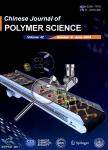Phosphine/Benzocyclone-based Neutral Nickel Catalysts for Ethylene Polymerization and Copolymerization with Polar Monomers
作者机构:Tianjin Key Lab of Composite&Functional MaterialsSchool of Material Science and EngineeringTianjin UniversityTianjin300072China Department of ChemistryLomonosov Moscow State UniversityRussian Federation InstitutionLeninskie Gory 1Moscow119991Russian Federation A N Nesmeyanov Institute of Organoelement CompoundsRussian Academy of SciencesVavilova st.28Moscow119991Russian Federation
出 版 物:《Chinese Journal of Polymer Science》 (高分子科学(英文版))
年 卷 期:2024年第42卷第2期
页 面:202-212,I0007页
核心收录:
学科分类:081704[工学-应用化学] 081705[工学-工业催化] 07[理学] 08[工学] 0817[工学-化学工程与技术] 070305[理学-高分子化学与物理] 080501[工学-材料物理与化学] 0805[工学-材料科学与工程(可授工学、理学学位)] 0703[理学-化学]
基 金:financially supported by the National Natural Science Foundation of China (No. 52130307)
主 题:Neutral nickel catalyst Ethylene polymerization Copolymerization Polar acrylate monomers
摘 要:The efficient copolymerization of olefin with polar monomers using nickel-based catalysts presents a longstanding challenge. In this contribution, three phosphine-benzocyclone ligands and corresponding neutral nickel catalysts(Ni1: Ar = Ph;Ni2: Ar = 2-(C_(6)H_(5))C_(6)H_(4);Ni3: Ar = 2-[2 ,6 -(Me O)_(2)-C_(6)H3]C_(6)H_(4)) were prepared and applied for the ethylene polymerization and copolymerization with polar monomers without any cocatalyst. The bulky substituent groups in complexes Ni2 and Ni3 contributed to high catalytic activities(up to 7.24×10^(6) and 9.04×10^(6)g·mol Ni^(-1)·h^(-1), respectively), and produced high-molecular-weight polyethylene(Mw up to 545.7 k Da). Complex Ni3 exhibited high activities for ethylene polymerization at the level of 10^(6) g·mol Ni^(-1)·h^(-1) across a wide range from 30 ℃ to 120 ℃, exhibiting excellent high temperature tolerance. These nickel complexes were also effectively employed in the copolymerization of ethylene with methyl acrylate, ethyl acrylate, butyl acrylate and lauryl acrylate, producing copolymers with high molecular weights(Mw up to 80.5 k Da) and high polar monomer incorporation(up to 8.2 mol%). Microstructure analyses revealed that the introduction of large sterically hindered substituents facilitated the incorporation of polar functional units into the polymer backbone. This study demonstrates the potential of these nickel-based catalysts for efficient copolymerization of olefin with polar monomers.



